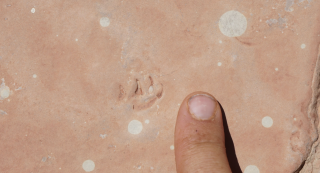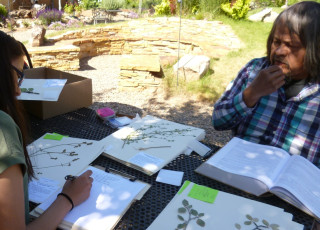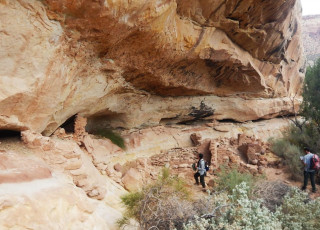Fossils at Bears Ears
By Beth Mitchell
A primer on the region, the fossils found so far, those that are likely to be there, and why it matters
If you’re anywhere in the Mountain West, chances are you’ve heard the name Bears Ears.
Unfortunately, politics has made Bears Ears more than a place; it’s a thing – a point of contention often divorced from the remarkable natural and cultural history that makes it such a treasure.
Luckily, NHMU’s very own Dr. Randy Irmis, Chief Curator and Curator of Palentology at the museum and Associate Professor in the Department of Geology and Geophysics on campus, and colleagues Robert Gay, Adam Huttenlocker, M. Allison Stegner, and Jessica Uglesich, have just published an article in the journal Geology of the Intermountain West that leads with science, and helps to set the (fossil) record straight.
Bears Ears
Let’s start with the basics. Bears Ears refers to a region in southeastern Utah, in what’s commonly known as Canyon Country. The ‘ears’, specifically, are the pair of similarly-shaped sandstone-caped buttes rising from Cedar Mesa, which – from a distance – give the impression of ursine ears poking above the horizon.
In late December of 2016, President Obama designated 1.4 million acres of the land in and around this area Bears Ears National Monument (BENM), which since then has been a landscape-scale national monument administered by the Bureau of Land Management (BLM) and the U.S. Forest Service (USFS), and part of the National Conservation of Lands system. Subsequently, in late December 2017, President Trump reduced the boundaries of Bears Ears National Monument by 85% with the remaining 15% comprising two distinct management units called Indian Creek and Shash Jáa.
Historically, the BENM region has been most recognized for the structures, rock art, and artifacts of the Ancestral Puebloan people, who lived in this area within the last two millennia. Equally rich, but less well-publicized, is that BENM preserves a rich history of ancient life extending back over 300 million years. Even so, many paleontologists agree that despite an abundance of paleontological resources within the Monument, they have not been extensively studied.
Highlights from the Field
So, to provide a baseline for effective management and preservation of these fossil resources, and encourage more study, the team set out to summarize what’s been found so far within the original and revised BENM boundaries, and what is very likely still out there -- just waiting to be discovered. In doing so, the team went back to 1859, when the first fossils were reported from the area, and through the early to mid-20th Century through the present, when geologists and paleontologists really dug in, so to speak, providing a better understanding of the age and paleoenvironments of sedimentary rocks of the area.

But it wasn’t just the rock itself – it’s what was in there: everything from the rise of the amniotes, shelled egg-laying limbed vertebrates that include all reptiles, birds, and mammals we see today, as well as their forebears over millions of years of evolution…that includes us!
Decades of discovery continued to deliver, with particularly significant discoveries from the 1970s through to the present. It is a point of fact that BENM is unusual because it has such a complete record of fossil-bearing sediments from between ~320 and 100 million years ago, providing a rare and nearly comprehensive picture of the ecosystems that emerged during the late Paleozoic and Mesozoic eras.
Teams from NHMU have been focusing their work on the early part of this time interval. Collaborative work between NHMU and the University of Southern California has discovered important new fossils from ~300 million years ago, when this part of Utah was a coastal desert, and animals with backbones were evolving to become fully terrestrial (i.e., not tied to water for reproduction). NHMU has also been collaborating with scientists from the St. George Dinosaur Discovery Site to investigate fossils from the very beginning of the age of dinosaurs, between 220-201 million years ago, and have discovered incredibly rich deposits of fossil fish, amphibians, and reptiles that document the last few million years of the Triassic Period, right before life was severely disrupted by the end-Triassic mass extinction.
Other research teams have been working in rocks from Jurassic and Cretaceous periods, ecosystems dominated by dinosaurs, and in the latter case, ecosystems that preserve the earliest flowering plants. Finally, hidden rockshelters and caves in BENM are critical archives documenting changes in plant and animal communities over the last 20,000 years, as Utah transitioned from the colder late Pleistocene to the relatively warmer Holocene.
So Much More to Discover
Regardless of the past/current boundaries of BENM, nearly all of the land is federally-managed public land, and therefore fossil resources are protected by the Paleontological Resources Preservation Act. This means, for one thing, that vertebrate fossils can’t be collected without a scientific permit and areas need to be surveyed for fossils before any land disturbance happens. But, land management agencies can’t effectively protect fossil resources if they don’t know where they are and how important they are. Illegal looting and vandalism of fossils from these lands has profound consequences for the possibility of their study and contextualization, and we are obligated to protect and preserve these fossils for current and future generations.

Why It Matters
The fossil record within BENM is one of the best places in North America to study several key paleontological intervals including the Carboniferous-Permian icehouse-greenhouse transition, the beginning of the age of dinosaurs, and how ecosystems in dry climates respond to sudden temperature increases. In other words, the big stuff: evolution and global climate change.
The institutions and teams -- NHMU is just one of many -- researching the geological time scale in this land need time, and access, to continue their research. And the stakes are high: protection and preservation of these natural and cultural resources will increase our knowledge and understanding of our planet’s history, and all who lived here.
Beth Mitchell is a senior staff member at the Natural History Museum of Utah, a part of the University of Utah in Salt Lake City. Our mission is to illuminate the natural world and the place of humans within it. In addition to housing outstanding exhibits for the public, NHMU is a research museum. Learn more.


